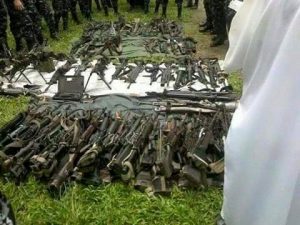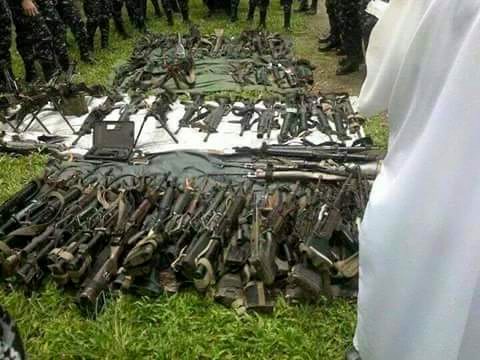It has been almost 70 years of civil war in Burma and it is ongoing. The country has become third world. People who own houses, farmland and plantations, have lost their properties and are forced to continue waiting for help and peace for the foreseeable future.
Respective armed groups have prepared their troops with a large number of weapons in order for them to continue their plight. They are now fighting against the Tatmadaw to have the rights for autonomy for their people and to create their own fate.
The Tatmadaw has also prepared their troops with new weapons paid for with the country’s budget. The justification is that they are buying weapons to protect the country.

We should consider whether the war investment has negative impacts or benefits for the people. It is necessary to think of saving people’s lives and properties from becoming lost to the war and think if such an investment was provided for development, we could see our country rescued from poverty.
I would like to share what a friend of mine, who is also a writer, divulged regarding the financial costs of war when using bullets and shells of AK-47, RPG, 79, 81 MM and 82 MM guns.
A pack of AK-47 bullets costs 1750 Kyat, a no.5 RPG shell is around 525,000, a pack of M-79 bullet is 35,000 Kyat. However, it is dependant on the currency rate which goes up and down, according to some ethnic armed groups.
Ultimately, in a war, if a 1000 pack of AK-47 bullets costing 1750 per pack were spent, it would be 1,750,000 Kyat. If a 5 RPG with the price of 525,000 for each pack is spent, it would be 25,750,000 Kyat. For 5 shells of a M-79, priced 35,000 for each, it would be 175,000 Kyat. Depending on the type of weapon, the prices can vary.
Therefore, we can now calculate the estimated cost of war. An amount of that estimated cost is spent while the fighting also leads to large losses of lives and the people’s houses and other properties as well as the destruction of villages and towns.
If we look at the military expenses of the Tatmadaw, the Defense Ministry spent 574.39 billion Kyat during the 2013-2014 fiscal year, according to a report presented at the Hluttaw as the Irrawaddy announced on February 26, 2013.
The Defense Ministry also reported to the Hluttaw that 2.4 billion Kyat was spent on military usage in the 2014-2015 fiscal year, while the ministry requested the Union Hluttaw [Parliament] in January for 2.750 trillion Kyat to use in the 2015-2016 fiscal year, according to a news report by DVB on April 27, 2015.
According to political analysts, the expenses of the Defense Ministry are more than expenses by other ministries, and because of that, it can affect the country’s development.
There are about 100 armed groups in the country including eight ethnic armed groups that signed the NCA with the government and 13 non-NCA signatories, militia groups, Border Guard Forces and other non-Tatmadaw groups.
According to the Myanmar Peace Center’s published book on the Peace and Nationwide Ceasefire Agreement, there are over 100,000 men from ethnic armed groups, in comparison to over 600,000 people forced to leave their homes.
Places where the fighting has taken place on and off are in the areas of Kachin Independent Organization/Independent Army, Shan State Progress Party/Shan State Army, Arakan Army, Myanmar National Democratic Alliance Army (MNDAA), and Ta’ang National Liberation Army and very recent clashes in Karen State. For example, the Tatmadaw launched attacks against the TNLA in early 2015 but clashes have taken place almost every day until 2016, while it has also fought with the MNDAA for almost 40 days, and the situations between the Tatmadaw troops and the TNLA as well as the MNDA remain tense.
Likewise, the Tatmadaw has armed engagements with Kachin Independent army, Shan State Progress Party and Arakan Army very often. Starting on September 8, 2016, the Tatmadaw in joint force with the Border Guard Force (BGF) have attacked Karen armed groups [Democratic Karen Buddhist Army] led by Brigadier general Kyaw Htet and Colonel Saw San Aung, a breakaway group from Democratic Karen Benevolent Army (DKBA), in the area of Mae Tha Waw, Hlaingbwo Township, and the fighting has escalated in the area until recently. As a result, more than 4000 people were forced from their homes and are taking shelter at Myaing Gyi Ngu Monastery.
We can estimate how much the fighting in Hlaingbwe Township will cost by looking at the arms expenses stated above. Almost 200 shells of 81 MM, 60 MM and 105 MM gun types, were fired into the area of Kachin Independent Army (KIA), in Kachin State, according to the interview with U Taung Kar (KIO/KIA’s technical advisor) by Eleven Media.
There have been millions spent for military motivations in the Laukkain war. However, that is not the amount of both sides’ combined but only from one side. They use RPG and 81 MM and a shell costs 4000- 5000 Kyat. A fighter can carry 150-180 packs during battle. This number can be higher depending on how long and how intense the fighting is. They carry 250-300 bullets for a machine gun. Lots of money was spent during the war in Kachin State, according to a researcher, who is studying ethnic armed groups.
If such expenses used in a war were put towards economic development, social welfare, education and health care, etc., we could rescue our country from the trap of poverty. It is necessary for every group involved in the war conflict to stop the war immediately and to spend such military expenses on the country’s development.
Hence, it is necessary to consider how much it has cost over the past six decades of civil war as well as the number of people who have lost their lives in the war. The author would like to urge a stop to the war immediately and a stop to spending money on acts that create hatred among ethnic nationalities, and instead, work towards national reconciliation and national development.

